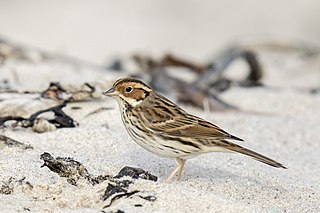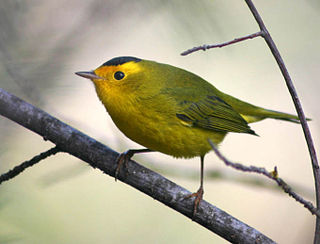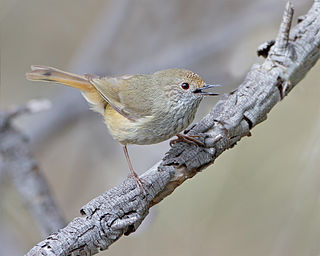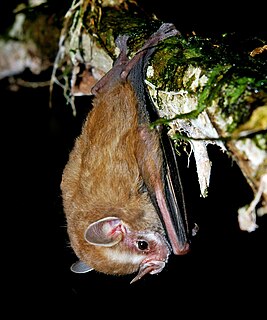
The semipalmated sandpiper is a very small shorebird. The genus name is from Ancient Greek kalidris or skalidris, a term used by Aristotle for some grey-coloured waterside birds. The specific pusilla is Latin for "very small".

The Baillon's crake is a very small waterbird of the family Rallidae.

The little bunting is a passerine bird belonging to the bunting and American sparrow family (Emberizidae), a group most modern authors separate from the true finches (Fringillidae).

The Wilson's warbler is a small New World warbler. It is greenish above and yellow below, with rounded wings and a long, slim tail. The male has a black crown patch; depending on the subspecies, that mark is reduced or absent in the female. It breeds across Canada and south through the western United States, and winters from Mexico south through much of Central America. It is a very rare vagrant to western Europe.

The field sparrow is a small New World sparrow in the family Passerellidae. It is about 140 mm (6 in) long and weighs about 12.5 g (0.4 oz). The head is grey with a rust-coloured crown, white eye-ring and pink bill. The upper parts are brown streaked with black and buff, the breast is buff, the belly is white and the tail is forked. There are two different colour morphs, one being greyer and the other more rufous.

Kogia is a genus of toothed whales within the superfamily Physeteroidea comprising two extant and one extinct species: Fossils date to the miocene

The brown-headed nuthatch is a small songbird found in pine forests throughout the Southeastern United States. The Bahama nuthatch was and still is considered a subspecies by several authorities including the IOC, but the IUCN and BirdLife International have reclassified it as its own separate species. The bird, like other nuthatches, possesses a sharp black nail-like beak, which it uses to pound open seeds. It is a frequent visitor to feeding stations and is highly fond of sunflower seeds and suet cakes.

The least auklet is a seabird and the smallest species of auk. It is the most abundant seabird in North America, and one of the most abundant in the world, with a population of around nine million birds. They breed on the islands of Alaska and Siberia, and spend the winter close to the edge of the ice sheet. Their largest colonies are on the Aleutian Islands, St. Lawrence Island and Little Diomede Island.

The brown thornbill is a passerine bird usually found in eastern and south-eastern Australia, including Tasmania. It can grow up to 10 centimetres (3.9 in) long, and feeds on insects. It is brown, gray, and white. The species has five subspecies.
The least big-eared bat is a South American bat species of the family Phyllostomidae, found in northwestern Brazil and eastern Colombia. It is monotypic within its genus.

The southern little yellow-eared bat is a frugivorous bat species from South America. It is found in Brazil, Argentina and Paraguay.

The least shrew tenrec is a species of mammal in the family Tenrecidae. It is endemic to Madagascar. Its natural habitats are subtropical or tropical moist lowland forest, subtropical or tropical moist montane forest, swamps, pastureland, and irrigated land. It is threatened by habitat loss.

The steppe pika is a small mammal of the pika family, Ochotonidae. It is found in the steppes of south Russia and northern Kazakhstan.

Micromonas is a genus of green algae in the family Mamiellaceae.

Malva pusilla, also known as Malva rotundifolia, the low mallow, small mallow, or the round-leaved mallow, is an annual and biennial herb species of the Mallow genus Malva in the family of Malvaceae. Malva is a genus that consists of about 30 species of plants. This genus consists of plants named mallows. Mallows grow in many regions, including temperate, subtropical, and tropical areas. (Persian: خبّازی، پنیرک)

Sybra is a genus of beetles in the family Cerambycidae, containing the following species:

Sybra umbratica is a species of beetle in the family Cerambycidae. It was described by Pascoe in 1865.
Sybra bioculata is a species of beetle in the family Cerambycidae. It was described by Pic in 1925. It contains four subspecies: Sybra bioculata bioculata, Sybra bioculata quadrinotata, Sybra bioculata sikkimana, and Sybra bioculata tigrina.

Sybra ordinata is a species of beetle in the family Cerambycidae. It was described by Bates in 1873.
Sybra pascoei is a species of beetle in the family Cerambycidae. It was described by Lameere in 1893.


















